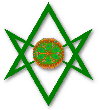What of Atlantis? Many modern human scholars, when asked this, point out that the Atlantis, as popularized by the human Plato, was actually the Minoan Island of Thera, that blew up in a massive volcanic eruption over three thousand years ago, giving birth to the legend, as well as various other events including the parting of the Red Sea. Never mind that Plato placed his Atlantis in the Atlantic, and the date of destruction at 9600 BC. They rightly point out that there is no geologic evidence to support an mid-Atlantic sunken continent. The Azores and Sargasso Sea are the usual locations given. And they are absolutely right! No lost continent ever existed in that location. But if one moves North up the Mid-Atlantic ridge, you come upon that long lost continent. It is still mostly submerged under water. But the difference is that the water is frozen. And the island continent is known by it's Norse name, "Grænnland" or Greenland. Of course the Plato account is not the only one that refers to this lost civilization. The ancient Britons knew this place as "Avalon." Other cultures also spoke of this long-lost mysterious place. The most detailed accounts we have today are primarily from channeled sources. The most famous of course being from the "Sleeping Prophet" Edgar Cayce. He recounts not one but three separate cataclysmic eruptions occurring over the course of some fifty thousand years. Cayce relates that the first Atlanteans were "energy beings" composed of pure thought. But over the course of tens of millennia, they became more and more corporeal as they lost their purity, with cataclysmic results. The last such eruption, which resulted in total annihilation according to Cayce happened some twelve thousand years ago, roughly the same time that Plato gives.
His coordinates for Atlantis are 80 degrees N. Latitude and 40 degrees W. Longitude. This is of course the coordinates for Greenland. His map, when flipped up-side-down and compared to a modern map of Greenland, reveals some striking similarities. Phylos' map includes the names of Atlantian cities. So what happened? All accounts agree with some cataclysmic event that destroyed the civilization. What occurred was yet another celestial bombardment. While nowhere near as big as the Great Shower, this series of impacts never the less was instrumental in modifying Thrawn's climate for many years to come. The impacts, that occurred in what is now Northern Canada created that region's most spectacular body of water, Hudson's Bay, and many of the smaller meterorite craters in that area. The impact again blasted a large portion of the atmosphere into space, which caused everything within a thousand mile radius to go from a temperate climate to sub-arctic in a manner of minutes. What actually occurred was that the planet was once again plunged into another Ice Age, resulting in the Island of Atlantis being first flooded by massive walls of water from the impact, and then flash-frozen as the air was sucked out into space. Over the years that followed, the snow and ice accumulated over the Northern lands, becoming up to several miles thick in the central island, as it remains to this day. With the thinned atmosphere, the Northern regions never returned to the same climate as before. But once the ice melts in Greenland, many strange and exotic things wait to be re-discovered. This could well occur within the next hundred years as global carbon dioxide levels increase, and the world warms yet again from the heat of Thrawn's growing consciousness.
Return to the SLU Home World |

 Another channeled account, less well known, comes from one "Phylos the Thibetan," who channeled his memories through the 18 year-old son of a Californian Doctor in 1884. In the book "A Dweller on Two Planets," (1952: Borden Publishing, Los Angeles; Illustrated by Ronald Clyne) Phylos recounts many day-to-day activities in Atlantis, describes the technology, including aluminum flying machines, atomic power and television. He also provides a map of Atlantis.
Another channeled account, less well known, comes from one "Phylos the Thibetan," who channeled his memories through the 18 year-old son of a Californian Doctor in 1884. In the book "A Dweller on Two Planets," (1952: Borden Publishing, Los Angeles; Illustrated by Ronald Clyne) Phylos recounts many day-to-day activities in Atlantis, describes the technology, including aluminum flying machines, atomic power and television. He also provides a map of Atlantis.